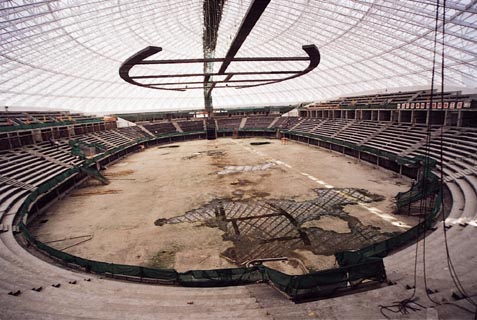 INTRODUCTION
INTRODUCTION
At the start of 1999, two large-scale stadium projects commenced in
Guangzhou in anticipation of the 9th People's Republic of China Athletic
Meet, to be hosted by the city in autumn 2001. The first project is
Guangdong Olympic Stadium located in Huang Chun, about 5 km east of
the Guangzhou East Station. The second is Guangzhou Gymnasium located
at the southeast corner of Baiyun Airport along the Guangzhou-Chonghua
highway.
This photo series serves
to give a general illustration of the later stages of construction for
these projects, and provides some details for the structural arrangement
of the stadiums.
Guangdong
Olympic Stadium
Guangdong Olympic Stadium is a 80,012-seat facility located on a 30-hectare
site, with a total building area of around 145,000 sq m. Facilities
include a 260 m by 200 m oval-shaped stadium structure with standard
track lanes, a soccer field, an arena and a series of practice gymnasiums.
Also provided are VIP boxes, a seven-storey guest house and car parking,
servicing and supporting facilities.
Design for the overall stadium complex was carried out by NEB Design
Group, a consortium that includes US-based design architect Ellerbe
Becket, project architect Nixon & Nixon, and architects of record
at the Architectural Design and Research Institute of the South China
University of Technology. The main contractor is the Guangzhou Province
Construction Group Ltd. Total cost of the project by its 1999 estimate
is about RMB1 billion.
Guangzhou is often dubbed China's Flower City and the stadium structure
is accordingly designed to resemble the mumian flower (木棉花);
the city's floral emblem. At the same time, the smooth rhythm of the
gently undulating stadium roof provides an impression of a waving
silk ribbon when viewed from far away. This roof has a covered area
of about 32,000 sq m and with a total weight of about 9,500 tons,
including the main steel frame and the decking materials. It is supported
by 21 four-legged column towers, representing the entrance into the
21st Century. To form the main frame of the roof, a pair of cantilever
steel truss frames is placed on top of each column tower. Each pair
of trusses is further linked up to the adjacent trusses by secondary
truss systems to form the on average four-metre-deep deep roof frame.
The main
trusses slightly tilt inward and cantilever above the field side for
about 52 m and outward for 10 m. At the outward tip, each pair of
trusses is tied down by a pair of 300 mm diameter cable stays attached
to the lower part of the column tower. Each column tower measures
8 m by 4 m at the stand level and has a clearance of about 13 m from
the upper part of the stand to the underside of each cantilevered
truss. The column towers are constructed of Grade 35 concrete.
Other main features of the stadium structure
are the elegantly arched column clusters and rib beams that support
the stands. There are altogether 12 sets of column clusters, most
of which feature different clearances, shapes and sections. Very stringent
quality and dimensional control was thus required during the design
and casting process for these columns. To ensure accuracy of the design
and dimensional control, all structural elements in the project were
surveyed and laid out using computer software such as AutoCAD.
The
construction period allowed for this project is around 33 months and
works have been phased into roughly three stages. The first 16 months
was for general foundation works and the stadium structural works
in reinforced concrete. It took another 12 months for the installation
of the steel roof structure and related decking works. The remaining
period is for final touch-ups, services installation and other external
or ancillary works.
The stadium is expected
to open on schedule for the October athletic meet.
<Photo
section click here>
Guangzhou
Gymnasium
This project is also a support facility for the 9th People
Republic of China Athletic Meet for competition, training and residence
purposes. The gymnasium complex comprises a main stadium, a practice
gymnasium, an activities centre for the public, an administration
building, an athlete’s residence, roadways and other service and supporting
facilities. The complex covers about 24 hectares of land. Besides
serving as a sports facility, the gymnasium can also be used as an
integrated cultural and recreation centre for the general public.
The largest structure in
the complex is the 10,020-seat main stadium, which is a 39,500 sq
m structure fully-enclosed with a roof spanning 160 m lengthwise and
110 m across. The practice gymnasium is 151 m by 70 m with a covered
area of about 19,400 sq m. The activities centre is the smallest of
the three large-span structures, with a covered area of 9,050 sq m
and spans of about 140 m by 30 m.
All the three structures
are designed with a arched steel truss girder across the length as
the main supporting frame. Multi-foci spine trusses span from the
reinforced concrete perimeter wall to the central main truss to form
the stadium structure's elliptical domes. The roof is clad with an
aluminum-framed double-layer translucent plastic sheet to allow the
best use of natural light during daytime events.
The three stadiums are
partially built below grade and the effect of buoyancy is catered
for by the provision of a series of anchor piles. Other geotechnical
difficulties encountered during construction included limestone caves
in the subsoil, active ground water, and strata of loose ground and
soft clay. Foundation systems employed are mainly 1 m to 2 m diameter
hand-dug caissons for the stadium structure, which is seated on a
reinforced concrete raft and tied down to ground with 150 mm mini-piles
to resist the buoyancy and uplifting effect.
<Photo
section click here>
|

 INTRODUCTION
INTRODUCTION